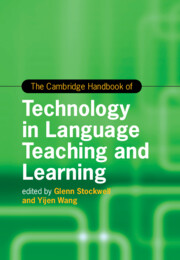Book contents
- The Cambridge Handbook of Technology in Language Teaching and Learning
- Cambridge Handbooks in Language and Linguistics
- The Cambridge Handbook of Technology in Language Teaching and Learning
- Copyright page
- Contents
- Figures
- Tables
- Contributors
- Abbreviations
- Part I Laying the Foundations
- 1 Introduction
- 2 Impact of Context
- 3 Current and Emerging Theories in CALL
- 4 The Shifting Focus of CALL Research
- Part II Environments
- Part III Tools
- Part IV Social Aspects
- Part V Practice
- Part VI Language Skills and Areas
- Glossary
- Index
- References
1 - Introduction
from Part I - Laying the Foundations
Published online by Cambridge University Press: 15 June 2025
- The Cambridge Handbook of Technology in Language Teaching and Learning
- Cambridge Handbooks in Language and Linguistics
- The Cambridge Handbook of Technology in Language Teaching and Learning
- Copyright page
- Contents
- Figures
- Tables
- Contributors
- Abbreviations
- Part I Laying the Foundations
- 1 Introduction
- 2 Impact of Context
- 3 Current and Emerging Theories in CALL
- 4 The Shifting Focus of CALL Research
- Part II Environments
- Part III Tools
- Part IV Social Aspects
- Part V Practice
- Part VI Language Skills and Areas
- Glossary
- Index
- References
Summary
This chapter introduces and explores the impact of context on technology in second language teaching and learning and the emerging theories that are shaping its future. The focus of research in this field has shifted toward blended and distance learning, flipped classrooms, and the use of mobile devices in low-tech environments. Teaching languages through games, Massive Open Online Courses (MOOCs), and virtual reality are also becoming popular. Social interaction, collaborative learning, learner motivation, and training are key factors in successful CALL implementation. Digital media are also being used to promote interculturality and develop literacies for teaching. Teacher resistance can be overcome through online communities for professional development. Task-based language teaching can improve the four language skills of reading, writing, listening, and speaking, as well as pronunciation, vocabulary, and grammar. The chapter concludes by outlining how technology can provide opportunities for language learning that can be tailored to individual needs and preferences.
Keywords
Information
- Type
- Chapter
- Information
- Publisher: Cambridge University PressPrint publication year: 2025
